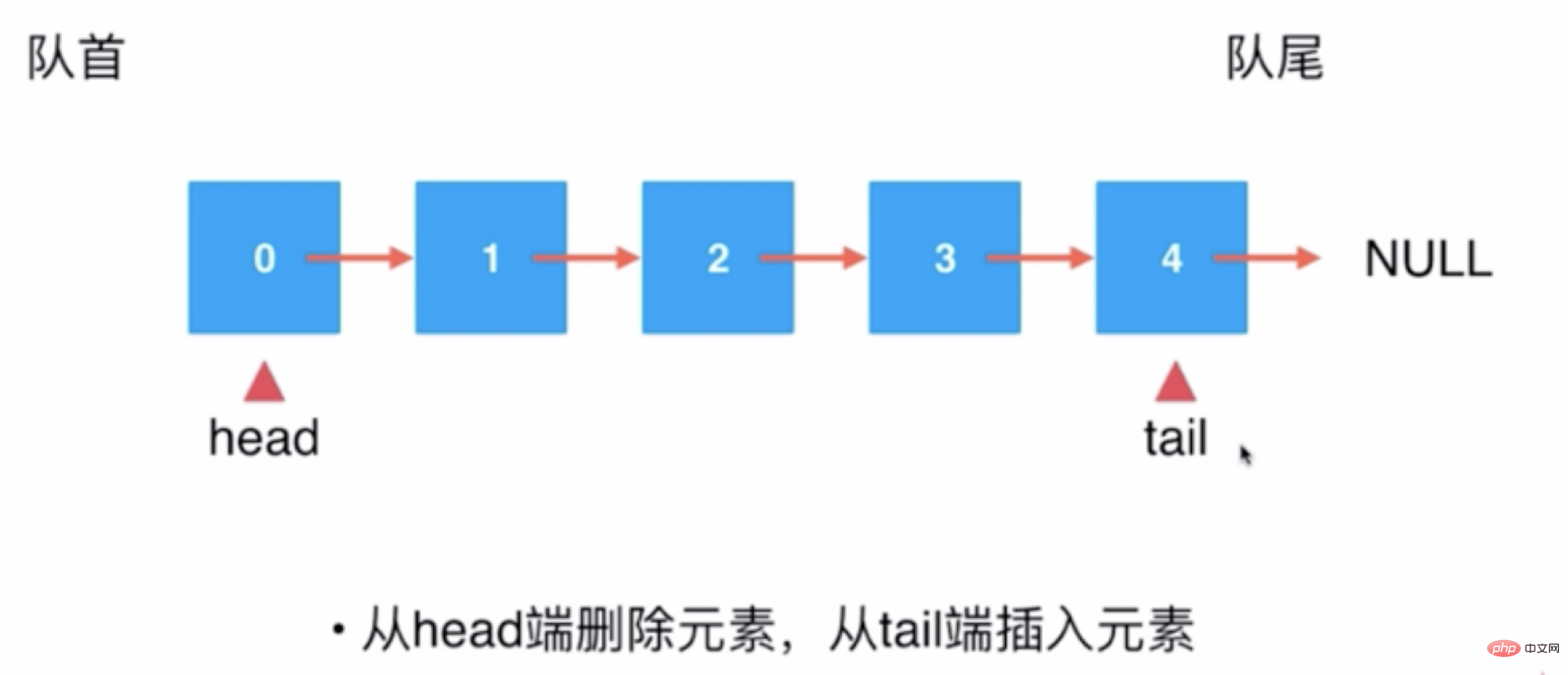Maison >développement back-end >tutoriel php >Explication détaillée de la façon d'implémenter une liste chaînée en PHP
Explication détaillée de la façon d'implémenter une liste chaînée en PHP
- 藏色散人avant
- 2021-05-17 16:39:464474parcourir
Cet article vous présentera l'implémentation de la liste chaînée en PHP. Il a une certaine valeur de référence. Les amis dans le besoin peuvent s'y référer. J'espère qu'il sera utile à tout le monde.
Apprentissage recommandé : "Tutoriel vidéo PHP"
Liste chaînée
Une liste chaînée est une structure de stockage non continue et non séquentielle sur un unité de stockage physique. L'ordre logique des éléments de données est obtenu grâce à l'ordre des liens des pointeurs dans la liste chaînée. Une liste chaînée se compose d'une série de nœuds (chaque élément de la liste chaînée est appelé un nœud) et les nœuds peuvent être générés dynamiquement au moment de l'exécution.
Formulaires : liste chaînée simple, liste doublement chaînée, liste à sauter (la structure des données de la collection Redis est réalisée par liste à sauter, complexité temporelle O (log N))
En savoir plus sur la liste à sauter : https : //lotabout .me/2018/skip-list/
php implémente les opérations d'ajout, de suppression, de modification et de requête sur les listes chaînées
Définir la classe de nœuds :
<?php class Node
{
public $val;
public $next;
public function __construct( $val = null, $next = null )
{
$this->val = $val;
$this->next = $next;
}
}
Liste chaînée classe :
<?php /**链表
* Class Linklist
* @package app\models
*/
class Linklist
{
public $head; //头节点(默认一个虚拟头节点)
public $size; //长度
public function __construct()
{
$this->head = new Node();
$this->size = 0;
}
//头插法
public function addFirst( $value ){
// $node = new Node($value);
// $node->next = $this->head;
// $this->head = $node;
//简化
// $this->head = new Node( $value, $this->head );
// $this->size++;
$this->add(0,$value);
}
/**指定索引位置插入
* @param $index
* @param $value
* @throws Exception
*/
public function add( $index, $value ){
if( $index > $this->size )
throw new Exception('超过链表范围');
// if( $index==0 ){
// $this->addFirst($value);
// }else{
$prev = $this->head;
for($i=0;$inext;
}
// $node = new Node($value);
// $node->next = $prev->next;
// $prev->next = $node;
$prev->next = new Node($value,$prev->next);
// }
$this->size++;
}
/**尾插法
* @param $value
*/
public function addLast( $value ){
$this->add($this->size,$value);
}
/***
* 编辑
* @param $index
* @param $value
* @throws Exception
*/
public function edit( $index, $value ){
if( $index > $this->size-1 )
throw new Exception('超过链表范围');
$prev = $this->head->next;
for($i=0;$ival = $value;
$prev = $prev->next;
}
}
/**
* 查询
* @param $index
* @return null
* @throws Exception
*/
public function select($index){
if( $index > $this->size-1 )
throw new Exception('超过链表范围');
$prev = $this->head->next;
for($i=0;$inext;
}
}
/**删除
* @param $index
* @throws Exceptionr
*/
public function delete( $index ){
if( $index > $this->size-1 )
throw new Exception('超过链表范围');
$prev = $this->head;
for($i=0;$inext = $prev->next->next;
$prev = $prev->next;
}
$this->size--;
}
/**检索值是否存在
* @param $value
* @return bool
*/
public function iscontain( $value ){
$prev = $this->head->next;
while( $prev ){
if( $prev->val==$value ){
return true;
}
$prev = $prev->next;
}
return false;
}
/**转换为字符串
* @return string
*/
public function tostring(){
$prev = $this->head->next;
$r = [];
while( $prev ){
$r[] = $prev->val;
$prev = $prev->next;
}
return implode('->',$r);
}
/**
* 删除指定的节点值
* @param $value
*/
public function removeFileds( $value ){
$prev = $this->head;
while( $prev->next ){
if( $prev->val == $value ){
$prev->val = $prev->next->val;
$prev->next = $prev->next->next;
}else{
$prev = $prev->next;
}
}
}
/**
* 通过递归方式删除指定的节点值
* @param $value
*/
public function removeFiledsByRecursion( $value ){
$this->head = $this->removeByRecursion( $this->head ,$value);
return $this->head;
}
public function removeByRecursion( $node , $value, $level=0 ){
if( $node->next == null ){
$this->showDeeep($level,$node->val);
return $node->val == $value ? $node->next:$node;
}
$this->showDeeep($level,$node->val);
$node->next = $this->removeByRecursion( $node->next,$value,++$level );
$this->showDeeep($level,$node->val);
return $node->val == $value ? $node->next:$node;
}
/**
* 显示深度
* 帮助理解递归执行过程,回调函数执行层序遵循系统栈
* @param int $level 深度层级
* @param $val
* @return bool
*/
public function showDeeep( $level=1,$val ){
if( $level<p>L'opération d'appel est la suivante : </p><pre class="brush:php;toolbar:false"><?php $node = new Linklist();
$node->addFirst(1);
$node->add(1,7);
$node->add(2,10);
$node->edit(1,8);
var_dump($node->select(1)) ;
$node->delete(1);
$node->addLast(99);
var_dump($node->iscontain(2));
var_export($node);
var_export($node->tostring());Analyser la complexité temporelle de l'opération de liste chaînée :
增: O(n) 只对链表头操作:O(1) 删: O(n) 只对链表头操作:O(1) 改:O(n) 查:O(n) 只对链表头操作:O(1)
Utiliser la liste chaînée pour implémenter la pile
<?php /**
* 链表实现栈
* Class LinklistStack
* @package app\models
*/
class LinklistStack extends Linklist
{
/**
* @param $value
*/
public function push( $value ){
$this->addFirst($value);
}
/**
* @return mixed
*/
public function pop(){
$r = $this->head->next->val;
$this->delete(0);
return $r;
}
}rrreeLa liste chaînée implémente la file d'attente

<?php $stack = new LinklistStack();
$stack->push(1);
$stack->push(3);
$stack->push(6);
$stack->push(9);
print_r($stack->pop());
print_r($stack->head);Test
<?php /**
* 链表实现队列
* Class LinkListQueue
* @package app\models
*/
class LinkListQueue extends Linklist
{
public $tail; //尾节点
/**
* push
* @param $value
*/
public function push( $value ){
if( $this->head->val==null ){
$this->tail = new Node( $value );
$this->head = $this->tail;
}else{
$this->tail->next = new Node( $value );
$this->tail = $this->tail->next;
}
$this->size++;
}
/**
* pop
* @return null
* @throws \Exception
*/
public function pop(){
if( $this->sizehead->val;
$this->head = $this->head->next;
$this->size--;
return $val;
}
/**
* 查看队首
*/
public function checkHead(){
return $this->head->val;
}
/**
* 查看队尾
*/
public function checkEnd(){
return $this->tail->val;
}
/**
* toString
*/
public function toString(){
$r = [];
while( $this->head ){
$r[] = $this->head->val;
$this->head = $this->head->next;
}
return implode('->',$r);
}
}Ce qui précède est le contenu détaillé de. pour plus d'informations, suivez d'autres articles connexes sur le site Web de PHP en chinois!
Articles Liés
Voir plus- Comment implémenter une liste à chaînage unique en php
- Implémentation Java d'une liste à chaînage unique (Liste chaînée) liée
- Une brève discussion sur la façon d'implémenter et de traiter les listes chaînées en PHP
- Une brève discussion sur les deux méthodes de mappage en PHP (liste chaînée et arbre binaire)

